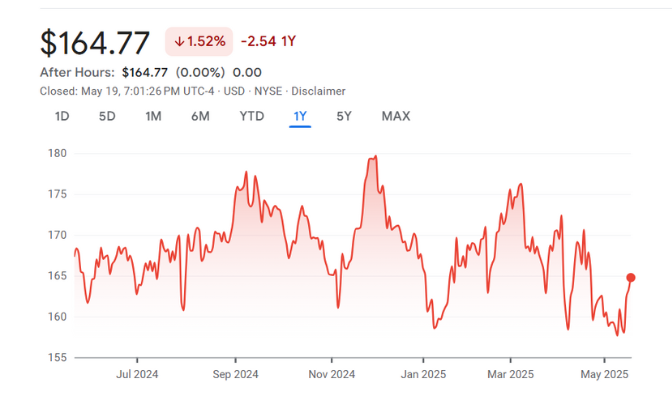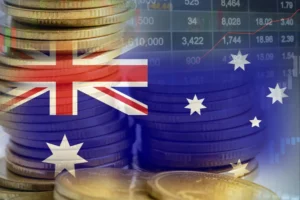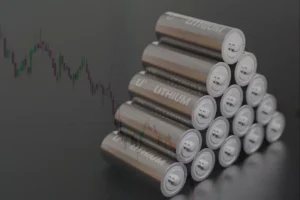Procter & Gamble Co. (NYSE: PG)Share Price and News

About Procter & Gamble
Established in 1837 by William Procter and James Gamble, Procter & Gamble has evolved into one of the world's largest consumer goods companies. Headquartered in Cincinnati, Ohio, P&G operates across five main segments: Beauty, Grooming, Health Care, Fabric & Home Care, and Baby, Feminine & Family Care.
Its extensive brand portfolio includes household names such as Tide, Pampers, Gillette, and Olay, serving consumers in over 180 countries. P&G's commitment to innovation and quality has solidified its position as a staple in households worldwide.
PG Company History
Procter & Gamble's journey began in the 19th century, supplying soap and candles. The two men who are the namesake of the company merged their companies together, observing that Cincinnatti had the chief ingredient for both soap and candles - animal fat. During the American Civil War, the company secured contracts to supply the Union Army, significantly boosting its profile. In the 1880s, P&G introduced Ivory soap, a product that floated in water, marking a significant innovation in the industry.
Over the years, P&G expanded its product lines and global reach, its focus on soap expanded into liquid detergents and it is behind the term 'soap opera' because it sponsored 'The Puddle Family' radio opera. It expanded into other brands including toothpaste, coffee and personal hygiene over time - a key step was acquiring Gillette in 2005 for US$57bn, the largest deal in its history.
In 2014, the company streamlined its operations by divesting around 100 brands to focus on its most profitable 65, accounting for 95% of its profits, but still continued to acquire. Key mobes included selling Duracell to Berkshire Hathaway in 2016, and buying the consumer division of Merck in 2018. In 2023, it unveiled another plan to cull brands contributing little to sales.
Future Outlook of Procter & Gamble (NYSE: PG)
In FY25, P&G anticipates all-in sales growth of 2% to 4% and organic sales growth of 3% to 5%, in line with earlier projections. While US-China trade tensions have contributed to input cost increases, recent agreements have reduced tariffs from previous highs of 145% to around 30%, easing some pressure on costs.
To mitigate these challenges, P&G plans to raise prices on select products and introduce higher-priced offerings. P&G has reaffirmed its core earnings per share (EPS) guidance for the financial year 2025 to be between $6.91 and $7.05 per share. Despite these near-term challenges, P&G continues to invest in innovation and consumer insights. In 2024, the company engaged in over 2 million research interactions to better understand consumer needs, driving product development and strategy.
P&G's strong brand portfolio and global presence position it well for long-term growth, even as it navigates current economic uncertainties.
Is PG a Good Stock to Buy?
Procter & Gamble's stock is often considered a defensive investment, appealing to those seeking stability and consistent dividends. The company has a long-standing history of dividend payments and plans to return approximately $10 billion to shareholders in the 2025 through dividends.
Additionally, P&G aims to repurchase $6 to $7 billion in shares, reflecting confidence in its financial health. Analyst sentiment remains cautiously optimistic. According to MarketBeat, P&G holds a consensus rating of Moderate Buy based on 24 analyst ratings, with an average price target of $178.52, representing a potential upside of 9.34% from the current price.
However, investors should be mindful of the potential impact of ongoing trade disputes and cost pressures on the company's margins. While P&G's robust brand portfolio and global reach offer long-term growth potential, short-term volatility may persist due to external economic factors.
Our Stock Analysis
Why the RBA Might Sit Tight For Some Time —But Investors Shouldn’t
The Reserve Bank of Australia (RBA) (as widely expected) to held the cash rate steady at its next meeting. Inflation…
Here’s How to Use AI to Pick Stocks and Whether or Not It is a Good Strategy
As Artificial Intelligence (AI) becomes more widespread, investors are asking how to use AI to pick stocks. We will cover…
Appen shares have plunged 90% from their peak! Is there any end to the bloodbath in sight?
There are few ASX shares that have seen such a fall from grace as Appen shares since 2020. In those…
6 Undervalued Lithium Stocks to Invest In
As the global push towards decarbonization accelerates, lithium has emerged as one of the most vital resources for a cleaner…
10 Best Solar Stocks to Buy in 2025
As the world shifts toward renewable energy, the solar industry has become a key driver of growth and innovation. Solar…
Artrya (ASX:AYA): Newly FDA 510(k) approved, and so its all systems go!
3 and a half years after listing and nearly 7 years after its founding, Artrya (ASX:AYA) achieved the aspiration of…
Frequently Asked Questions
As of May 2025, P&G's annual dividend payout is $4.23 per share, resulting in a dividend yield of approximately 2.59%.





